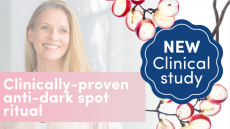Vitamin, minerals may reduce eczema risk in children
Children with the highest average intakes of the four nutrients were found to have significantly lower risks of atopic dermatitis, than children with the lowest average intakes, according to findings published in the European Journal of Clinical Nutrition.
Researchers from Kyung Hee University in Seoul used both data on intakes of vitamin and minerals, and corresponding biomarkers, in relation to atopic dermatitis, the first time such an approach had been used.
Atopic dermatitis (AD), characterised by areas of severe itching, redness and scaling, is one of the first signs of allergy during the early days of life and is said to be due to delayed development of the immune system. According to the American Academy of Dermatologists it affects between 10 to 20 per cent of all infants, but almost half of these kids will 'grow out' of eczema between the ages of five and 15.
Study details
The Seoul-based scientists recruited 180 five-year olds with AD, and 242 five-year olds without AD and assessed their diets using a validated semi-quantitative food frequency questionnaire (FFQ). Blood samples were also taken after a period of fasting to determine levels of fat-soluble vitamins, like retinol, alpha-tocopherol (a form of vitamin E), and beta-carotene, and vitamin C.
Results showed that the risk of AD was 56 per cent lower in children with the highest average intakes of beta-carotene, compared to the lowest.
Moreover, dietary vitamin E, folic acid, and iron were associated with 67, 63, and 61 per cent reductions in AD risk, added the researchers.
The dietary intake data was also matched by data from the blood samples, with the highest average levels of alpha-tocopherol associated with a 36 per cent lower risk of AD, while retinol was associated with a 26 per cent lower risk.
“These findings suggest that higher antioxidant nutritional status reduces the risk of AD and that such risk-reduction effects depend on nutrient type,” wrote the researchers.
Benefits are skin deep
Commenting on the possible mechanism, the researchers note that reactive oxygen species (ROS) from environmental pollution and the sun may promote oxidative damage to proteins in the outermost layer of the skin (stratum corneum), which would exacerbate AD.
“Antioxidant nutrients have been proposed to counteract oxidative stress and inhibit the inflammatory response and are known to be possibly associated with the ability of the individual to restrain the inflammatory response and allergic diseases,” they added.
The subject of antioxidants and health will be discussed in more detail at the upcoming conference, NutraIngredients Antioxidants 2010: Science, Testing and Regulation. For more information about the conference, please click here.
Source: European Journal of Clinical Nutrition
Published online ahead of print, doi:10.1038/ejcn.2009.148
“Antioxidant nutrient intakes and corresponding biomarkers associated with the risk of atopic dermatitis in young children”
Authors: S-Y Oh, J Chung, M-K Kim, S O Kwon, B-H Cho
-----------------------------------------------------------------------
Reader response:
As you reported, the authors said that their findings "suggest that higher antioxidant nutritional status reduces the risk of AD". However, this was an observational study, not an intervention trial. The authors simply looked at dietary intakes (by the fairly inaccurate method of a food frequency questionnaire) and blood levels of nutrients in children with and without AD. Just because they found a difference in intakes/status does not imply that there was a causal relationship between specific nutrients and the risk of AD.
Another explanation for the results could be that children with AD ate poorer diets, perhaps due to fussiness or parental concerns about allergy. It might be that children with AD avoided some types of fruit or vegetables because these were perceived by parents to exacerbate their condition. This would have impacted on intakes of beta-carotene, vitamin E and folic acid. Lower meat intakes would have impacted on iron intake and status. I think that implying a causal relationship from this type of study is unwarranted – we would need a placebo-controlled intervention trial to work out whether or not these nutrients are helpful for AD.
I’m sure this would explain things better to non-scientist readers who probably think we can translate observational studies straight into nutrition policy!
Carrie Ruxton PhD, RD
Nutrition Communications











